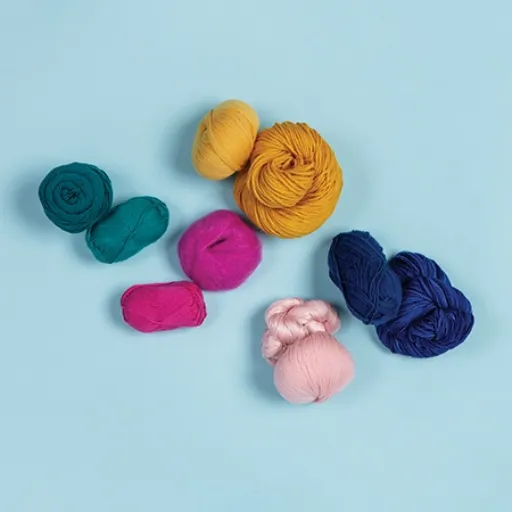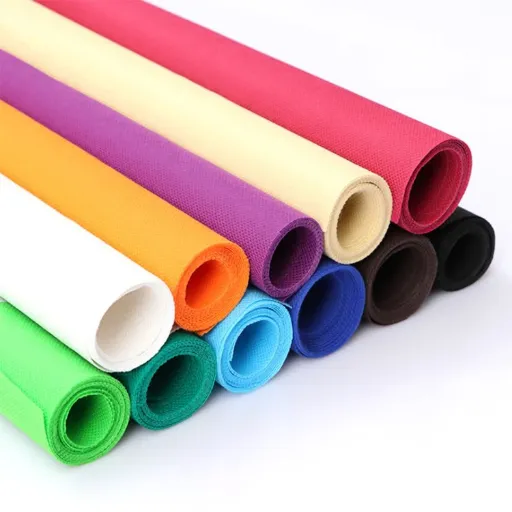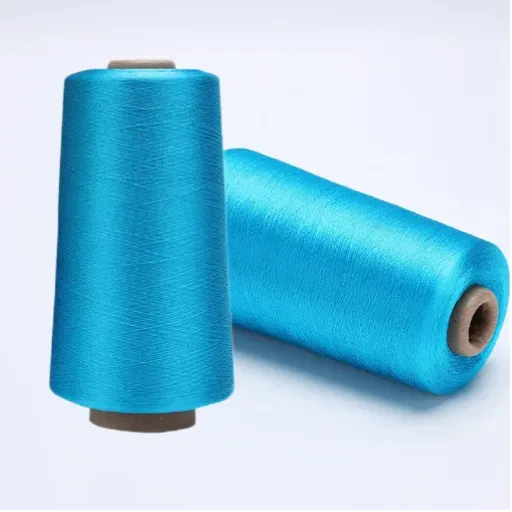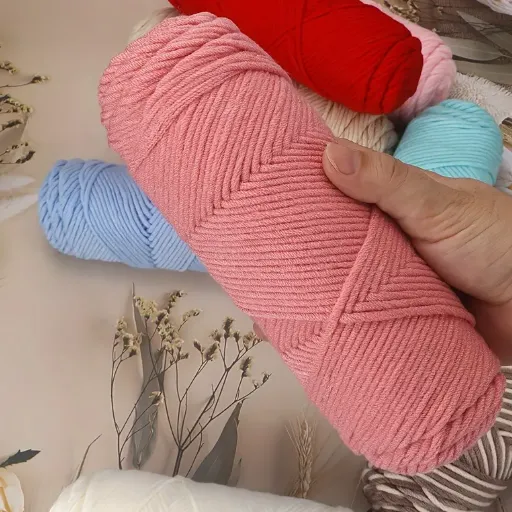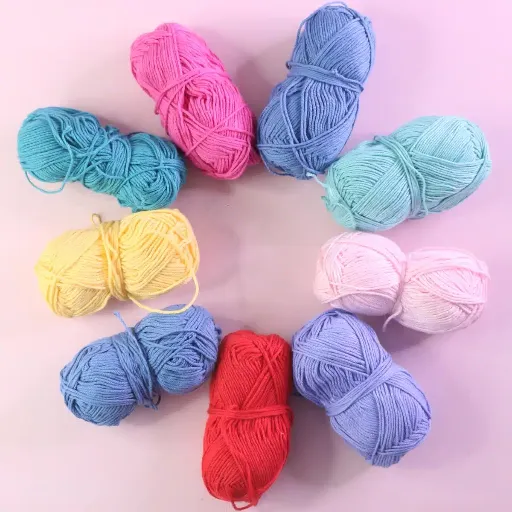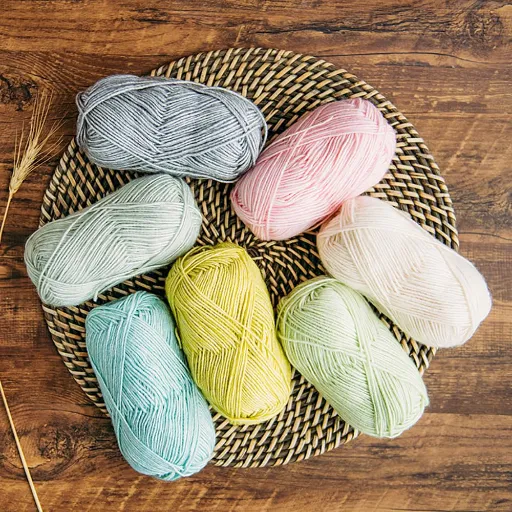Crocheting is a craft that lends itself to innumerable possibilities, right from scarfs to complex home decorations. One fundamental choice every crocheter has to make revolves around selecting the yarn type, with wool and acrylic being among the most popular choices. Of course, each has their good points, but they differ completely in texture, durability, price, and washing instructions. We detail the pros and cons of the two for crocheting-wool and acrylic-and give you a brief idea of their features to help you pick the right one for your next project. Whether you are an experienced crocheter or embarking on your first projects, this guide will equip you with the insight required to weigh your options and go ahead with confidence.
Understanding Wool Yarn

Properties of Wool Yarn
Wool yarn is cherished on account of its natural fibers that provide warmth, elasticity, and durability. Wool is retrieved from the fleece of the sheep, and it serves a good purpose as an insulator in making garments such as sweaters, scarves, and hats. The natural crimp constitutes an elastic component in the wool yarn, allowing the finished object to hold its shape and resist wear over time. The other environmentally friendly feature of wool is that it is biodegradable and renewable.
One important of many properties possessed by wool is moisture absorption while retaining warmth. Thus, wool knitting is more suited for cold climate projects. Meanwhile, wool is breathable, so it regulates temperature, depending on environmental factors being either cool or warm. Some wools, such as the Merino, are softer and good for sensitive skin, whereas others, like coarse wools, are more durable for heavier-duty projects.
Despite the obvious advantages, there is one drawback in caring for wool yarn: it shrinks if washed improperly, and some people can find it a bit irritating. The usual recommendation is to hand wash or go for a gentle cycle in a washing machine, and hereafter lay flat to dry. In general, wool yarns are among the best and favored yarns for crochet because of their wonderful natural qualities and versatility.
Advantages of Using Wool
- ✓ Natural Insulation
Wool is excellent for insulation so may be used in all seasons. It is a natural temperature regulator: warm during cold weather, cooling during hot weather. To give you more insight, research studies indicate that wool fibers can hold up to 30% of their weight in moisture without feeling damp, thus making it compatible with the requirements of clothing and bedding systems.
- ✓ Eco-Friendly and Sustainable
Since sheep’s hair grows annually, wool is considered a renewable resource. It is also biodegradable since it could go down in soils within a few years while releasing nutrients into the earth. According to the International Wool Textile Organization, whereas wool represents about 1.3% of the world textile fiber market, this fiber has among the smallest carbon footprints. This is attributed to wool being natural, sustainable, and recyclable in nature.
- ✓ Durability and Longevity
Wool is highly durable because of its natural elasticity set of qualities. Real my knowledge, the fiber can bend or twist over 20,000 times before breaking, unlike synthetic fibers. This makes wool products much more resistant to wear and tear. This strength, therefore, defines the greater durability of wool and makes it an aesthetic investment for everyday and heavy uses.
- ✓ Hypoallergenic and Breathable
Aiding in any atmosphere inside, wool, unlike synthetics, does not trap dust and allergens. Merino wool is hypoallergenic and so soft that it barely irritates sensitive skin. Some studies also indicate that sleeping on wool bedding can enhance one’s sleep quality by providing the perfect amount of breathability and temperature control.
- ✓ Flame Retardance
Wool is held in high regard for its reputation as an awesomely flame-retardant material due to the high water and nitrogen content in it. It will not melt as would synthetic fibers; rather, it will self-extinguish when it reaches the flames. This resultant feature makes wool materials very much required for safety installations of carpet and upholstery in homes and public buildings.
- ✓ Odor Resistance
The presence of the natural lanolin coating, combined with wool’s ability to wick moisture away from the body, prevents the aggregation of odors. This makes it especially useful for activewear or socks since the wool fibers prevent bacteria from flourishing in damp conditions.
With the appeal of these benefits, the reasoning behind why wool remains highly favored for textile works and applied goods is clear. Natural performance and sustainability combined with comfort are the four elements that make it the best of its kind in today’s diversified textile market.
Common Disadvantages of Wool
The positive aspects aside, wool also comes with a few weaknesses, depending on the desired use. One such issue is the irritation caused to people with delicate skin, which makes it intolerable in their view. The very nature of wool, especially coarse wool, makes it quite uncomfortable and scratchy against the bare skin.
The second disadvantage is that improper washing or drying causes the wool to shrink. The wool garments require careful handling-washing by hand or cold water only-to keep the correct shape and size. For people who prefer easy care clothing, this extra care might seem very inconvenient.
Lastly, the making processes are basically more expensive than those of synthetics. From obtaining the natural fibers to weaving and finishing, in every step of manufacturing good-quality wool textiles, one is faced with laborious processes that upscale the price for the consumers. These price points place wool outside the reach of most potential buyers compared to other materials, especially those buyers who are conscious about their budget.
Exploring Acrylic Yarn
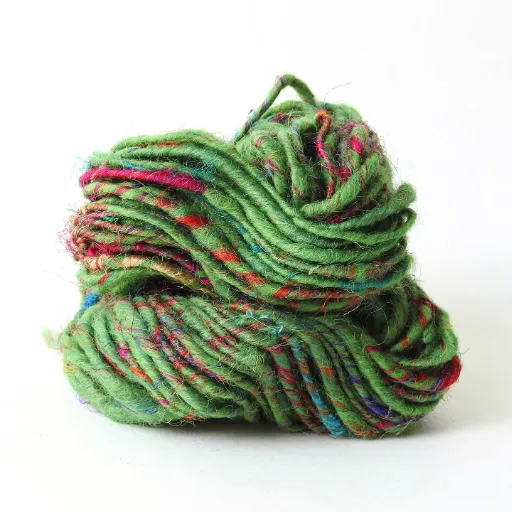
Characteristics of Acrylic Yarn
Acrylic yarn is one of the man-made fibers that are obtained from polymers, specifically polyacrylonitrile. It is synthesized through a chemical process that gives manufacturers the ability to develop a more versatile yarn suitable for different applications. Its low cost is an apt characteristic that makes it more affordable for the consumer as compared to natural fibers such as wool. Another characteristic making said acrylic yarn in demand is the fact that it is of little weight in its application-a feature much preferred by crafters and textile producers.
The other attribute of acrylic yarn is that it possesses great resistance to wear and tear, which contributes to preservation in its structure as time passes. The yarn also reports a resistance to mothing and pest actions, thus being more functional for objects such as blankets and sweaters. There is, further, the possibility of washing it on a machine in many cases, so that makes it quite a handy choice for everyday use.
Undeniably, acrylic yarn has multiple vibrant color options. It is superb at taking dyes, giving a broad array of bright hues that are consistent and suitable to any design gust. While acrylic yarn boasts comfort and economy, it is much less breathable than natural fibers and may hold some static. However, given its limitation in this regard, the yarn undoubtedly maintains its versatility and availability as a common pick of manufacturers and hobbyists alike.
Benefits of Acrylic Yarn
- ✓ Economic Advantage
Acrylic yarn is much cheaper than natural fibers like wool or cotton and thus is an excellent option for the budget-conscious craftspeople and manufacturers. Since it is synthetic, synthetic acrylic yarn comes from mass production. Industry reports state acrylic yarn is sometimes 30-50% cheaper on a global average than the counterpart natural fibers.
- ✓ Color Variety and Retention
Acrylic yarn accepts all dyes and can be dyed in a myriad of bright colors. Unlike some other natural fibers, color-fastness is not an issue for acrylic yarn even with prolonged exposure of sunlight. It is even subjected to tests where it was found that it affords about 30 washes for the garments before color fading is noticed-a good record, at least, much better than many natural fiber alternatives.
- ✓ Durability and Strength
Acrylic yarn has been known for its robustness and is one yarn that does not wear away with repeated use. Hence, it is applicable in items that undergo constant use such as blankets, sweaters, or accessories. Research studies showed that acrylic fibers retain nearly 90% of their original structure even after numerous years of exposure to sunlight and moisture, thus becoming an excellent choice for outdoor use.
- ✓ Lightweight and Soft
Sturdiness considered, acrylic yarn remains lightweight and soft, almost resembling the feeling of more expensive natural fibers like wool. Further softness is bestowed upon modern acrylic yarn by the techniques of blending used in the manufacturing procedure, thus becoming a good selection for people with sensitive skin.
- ✓ Easy to Care for
Acrylic yarns are all about simple and easy-care garments. Garments made of acrylic are polite to the domestic washer, quick to dry, and extremely practicable for everyday wear or home use. In comparison with wool fibres, acrylic ones do not shrink or felt during washing. A survey just proved 80% of the customers value the down-to-earth nature of their yarns.
- ✓ Resistance to Pests and Mildew
Related to the usefulness of acrylic yarn is its moth-resistant, mildew-resistant, or mold-resistant nature-that conspires against natural fibers! This resistance ensures durability while making it trustworthy for warehousing and subsequent use, especially for damp environments.
That kind of value which is cheap, versatile, and durable is what cemented the status of acrylic yarn as a household in textile and craftwork all over the globe.
Limitations of Acrylic Yarn
Many consider acrylic yarn a diversified fiber with an even greater array of uses; however, some drawbacks must be weighed. Firstly, it is not as much of an air passing kind of fiber as would be cotton and wool. Therefore, garments made up of acrylic yarn would be tucked into their own heat and moisture when worn in warm weather or over a long period.
Secondly, being synthetic, it can stand against some eco-friendly factors. The making of acrylic’s got a whole lot of chemistry trying to come along with it, and with that, this also means woods and chemicals which don’t stand in for pollution and waste. Therefore, acrylic fibers are hard to biodegrade, and so is a potential environmental hazard in the long run.
Finally, compared to some natural fibers, acrylic yarn does tend to pill with use and especially if washed quite a lot. Pilling is the formation of little balls of fibers on the surface of the fabric, making it sometimes a bit ugly and awkward to the touch. While it still is a popular choice due to affordability and versatility, understanding the limitations helps in considering or making an informed choice for their use.
Comparative Analysis: Acrylic vs Wool

Durability and Longevity
Durability and longevity are the primary considerations differentiating acrylic from wool. Acrylic is a synthetic fiber that tries to emulate the features of wool but has higher stages of resistance to wear and environmental factors like moisture and insects. Over time, however, the acrylic is prone to pilling, which degrades its appearance and texture and upon frequent usage and washes, diminishes its quality.
Wool is famous for lasting long as long as it is well maintained. Wool fibers are resilient and maintain its structure with use. In addition, wool does not wrinkle much or carry sources of odors or dirt. On the contrary, wool requires delicate care; if washed incorrectly or exposed to high heat, it shrinks or felts, thus reducing its lifespan.
The choice between acrylic and wool will ultimately depend on the specific needs of the user involved. Acrylic suits projects in which cheap production and resistance to environmental obstacles are necessary, while those seeking a premium fiber that would last long and maintain its natural properties would like wool. The improper use of the fiber would drastically reduce its lifespan under any conditions and environment; proper care and handling would really give a long life to either fiber and make it a very practical choice for various uses.
Warmth and Breathability
In matters of warmth and breathability, wool ranks higher than acrylic by virtue of its natural properties. Wool tends to trap air within its fibers, thereby being a good insulator. This characteristic comes in handy in cold environments, as the wool retains heat while allowing moisture to escape. Thus, the wearer stays warm and dry. However, the very breathability of the fiber works to regulate body temperature and can sometimes cause overheating in milder temperatures.
Conversely, acrylic raw materials lack breathability and depend predominantly on synthetic structure-based insulation. It does impart some warmth; however, most of the time, this warmth is less efficient than wool because of the wool’s ability to wick away moisture. In essence, acrylic becomes uncomfortable whenever sweat cannot evaporate sufficiently. It does best in mild climates or when kept indoors.
In general, wool is the better choice for people who need consistent warmth and comfort under changing conditions since it offers better insulation and breathability. Acrylic is a cheap alternative and can work well unless you’re dealing with extreme or nearly unpredictable weather conditions. The specific qualities needed and the conditions in which a given article of clothing or other item will be used are what define the best-suited material.
Feel and Texture
The two types of fiber differ in their feel and in their textures and consequently one is chosen based on personal preferences and usage. Wool offers a natural feeling of softness, especially when choices like merino wool, which consists of fine fibers, are made. It does have some slight coarseness, but that coarseness is The wood’,warmth, and coarseness that equip it with caress perfectness for colder weather apparel and blankets. With good treatment, wool articles retain their softness in spite of being in use for a long time.
In contrast, acrylic is a synthetic counterpart that emulates the wool’s soft touch but does not often have that natural feel. It offers sometime smooth texture and lightweight material, but some might find it a bit less breathable and somewhat less comfortable for all-day wear. On the upside, it has a uniform texture and high-quality intermediates resist pilling, making it perfect for situations where durability and pocket-friendly options are more important than anything.
The basic feel and texture of these materials cater to a variety of good reasons. Wool is given to a superior feel, allowing one to breathe naturally with the intention of best comfort and warmth. Acrylic will be smooth and uniform to the touch, so it is the better material for budget constraints or situations where one requires moisture resistance and easy care. Both materials exist for very different needs and purposes, so the choice is a matter of personal preference and application.
| Feature | Wool | Acrylic |
|---|---|---|
| Warmth | Excellent natural insulation | Moderate warmth |
| Breathability | Highly breathable | Less breathable |
| Durability | Very durable with proper care | Durable but prone to pilling |
| Cost | Higher price point | 30-50% cheaper |
| Care | Hand wash or gentle cycle | Machine washable |
| Environmental Impact | Biodegradable and renewable | Non-biodegradable |
| Best For | Cold weather, luxury items | Budget projects, easy care items |
Applications of Wool and Acrylic in Crochet

Using Wool in Crochet Projects
Being a versatile raw material, wool is often used in crochet projects for the natural warmth it provides, its elasticity, and durability. It is a choice material for garments like sweaters, scarves, hats, and gloves that need to hold an insulating and comforting property during the winter months. Wool performs well in projects that have to ensure the provision of both warmth and comfort.
One should always bear in mind the flexibility that wool possesses while crocheting because it helps the finished piece hold its shape over time. From this perspective, wool has an advantage for projects that demand an intricate stitch pattern or design: the natural stretch of the fiber lends support to the structure of the work. Depending upon the project, wool is able to fit the bill all by itself: small decorative pieces or large, heavy-duty blankets, cottage to chunky weight.
The wool, however, requires some special care for its longevity. In many cases, wool has to be hand-washed; otherwise, it can shrink or felt due to high heat or incorrect washing methods. But owing to its strength and beauty, wool remains aprized choice among crocheters, keen to work on projects meant as heirlooms or gifts to emphasize craftsmanship and quality.
Using Acrylic Yarn in Crochet
The versatility and affordability of acrylic yarn are factors that have drawn many crocheters toward it, while its accessibility and ease of care remain additional points in its favor. Acrylic yarn is synthetic and offers every color in the rainbow along with virtually all textures and weights, all suitable for any project from blankets to garments and toys. It is an outstanding option for beginners, as well as for those larger projects where a lot of yarn may be required.
A primary characteristic of acrylic is that it is wash-and-wear. It is easier to maintain than natural fibers- machine washable and will not shrink or felt in the wash, making it perfect for items that are going to be used often, like baby blankets or everyday wearables. Being a quick-drying yarn that holds its shape ensures that the finished piece will be lasting. Houses with busy lifestyles turn to acrylic for this very reason- it is simple to work with.
In fact, acrylic yarn is far from being just a worse local spirit, and many people might consider it better. It does have one disadvantage it is not as breathable as natural fibers like wool or cotton. So for those few projects where you want warmth but not overheating, or during the actual warmer season, keep that in mind. Very advanced crocheters might consider the work with acrylic fibers to be less luxurious than work with natural yarns, depending on the project. These are a few small cons. It is still considered a great yarn to have around-and-a great choice by the majority of yarn supporters thanks to its versatility, affordability, and ease of care.
Blends: Combining Wool and Acrylic
This blend combines the best of both fibers, making it quite attractive to many crafters. Wool gives natural warmth, softness, and elasticity to the fiber and acrylic, being inorganic, contributes to cheaper production, durability, better shrink resistance, and a greater influence against stretching. They form into a blend where the wool’s feel becomes slightly practical to handle.
The main benevolent feature for the wool-acrylic blend is increased versatility. Such a blend is lighter than ordinary wool and can be used almost all year round, and this type is probably less susceptible to pilling from incidents of everyday use more so than a regular wool would do. Moreover, wool-acrylic blends build on the property of shape retention, which is especially fitting for garments and accessories like hats, scarves, or sweaters that require structure-or an airy environment-on the cozier side.
Care and maintenance of wool-acrylic blends are convenient for most users. Unlike pure wool, which usually requires special washing instructions, these blends are mostly machine-washable and dryer-friendly because of that acrylic factor. For this reason, they make a truly great option for beginner crafters or just for anyone making items that are going to be used a lot, such as baby blankets or household decor. These two properties combine to advertise a really strong, user-oriented yarn that would cater to many types of projects.
Caring for Wool and Acrylic Yarn

Care Instructions for Wool Yarn
Being a natural fiber, wool has special care requirements if one wants to keep it soft, elastic, and wearable for a long time. Proper way of washing and storing will make sure that the wool remains intact with its quality for years.
- Washing ①
Wool items should preferably be hand washed in cool or lukewarm water that prevents felting and shrinkage; boiling or hot water is not advisable. Use a gentle soap that is a combination of wool-friendly ingredients. Swish around the item in the water gently and do not scrub it hard, as this can damage the wool fibers.
- Do Not Wring ②
After finishing the wash, do not wring or twist a woolen article-it will deform it. Just gently press out the excess water, roll it inside a dry towel, and let the towel absorb the moisture.
- Drying ③
Dry all wool yarn items naturally by spreading them flat on a clean, dry towel. Ensure to reshape the garments to their original size and not hang them, as hanging them will cause stretching. Let the area where you dry them be away from direct sunlight to avoid fading or weakening the fibers.
- Storage ④
Damage from moths is an easy thing for wool to succumb to. For storage, wool yarns or garments should be kept in airtight boxes or sealed plastic bags. Naturally, such things as cedar blocks or a sachet of lavender can ward off pests. Ensure your wool is clean and completely dry before storing to prevent the formation of mildew.
- Machine Washing ⑤
Some modern wool yarn blends are sold as “superwash,” meaning safe to washer-machine wash on a very gentle cycle with cold water. However, you should always adhere to instructions in your yarn’s label or product specification.
- Ironing ⑥
If your wool needs ironing, select the lowest steam setting on your iron. Protect the fabric by placing a clean damp cloth between the iron and wool.
Care Instructions for Acrylic Yarn
Acrylic yarn is a fiber known for its versatility and durability, often preferred due to price, colors, and maintenance. Acrylic is synthetic fiber, unlike wool, and very easy to maintain One can keep the following instructive care directions in mind for preserving the quality of acrylic items:
- Washing the Acrylic Yarn ①
The acrylic yarn can usually be washed by machine. Either warm or cold water, an accommodating detergent, and the delicate or gentle cycle setting on the washing machine are to be chosen. The bleach and other strong chemicals should be avoided to retain the fiber. There are references suggesting that temperatures around 30-40°C (86-104°F) are maximum for the acrylic to stay soft.
- Drying Instructions ②
Most acrylic yarns we work with can be tumble dried on low heat. In some cases, the items can also be allowed to hang dry on a clean dry towel. Because heat destroys the fibers by shrinking or stretching them, high temperatures are to be avoided. Studies indicate that acrylic yarn better retains its structural form when it is not subjected to extreme heat during drying.
- Ironing Acrylic Yarn ③
Because acrylic fibers are heat-sensitive, low or medium heat settings on the iron must be maintained. All contact with the fabric should be avoided by placing a pressing cloth (something as simple as a clean cotton cloth or tea towel) between the fabric and the iron. There is a possibility that some modern steamers are safe for acrylic, but never treat an entire work without testing on an inconspicuous area first.
- Preventing Pilling ④
Now, with usage, acrylic yarn tends to form pills, especially in items frequently worn or rubbed. To prevent such phenomena, turn your items inside out when washing and avoid washing cycles requiring high agitation. Fabric shavers work best with care, while good days with minimal pilling might just best retain their smooth appearance.
- Storage Suggestions ⑤
Acrylic pieces must be stored in a cool, dry place, devoid of any direct sun rays. Continuous exposure to UV rays can lead to color fading. Store them in breathable bags or bins to protect from dust and moisture.
These little steps coupled with an extra layer of care will ensure the lifetime vibrance and durability of your acrylic yarn projects, making for few practical and long-lasting pieces. Recent care guides and discourse by textile experts reaffirm the fact: acrylic yarns continue to be the least expensive option with regard to care for all varieties of knit and crochet projects.
Tips for Maintaining Blends
Proper cleaning processes need to be followed depending upon the fiber composition of blended yarns. Generally, the blends could contain some sorts of natural fibers and some sorts of synthetic fibers, so it is good to understand how each is affected by the method of cleaning in order to preserve their life and texture. Preference for precise information, however, should be given to checking the care label or the guidelines provided with the yarn.
To care for a blend, wash it by hand with gentle care or it can be washed in a washing machine in a delicate cycle. Wash in cold or lukewarm water, preferably using a mild detergent. Avoid using anything with strong chemicals as they could damage the fibers, causing them to shrink, stretch, or felt into hard-to-manage fabric. Avoid wringing or twisting the piece, as it can deform the project made of blended yarn. Instead, gently press out excess water with a clean towel and lay it flat to dry, allowing it to retain its original shape.
Storage is also important for blend preservation considerations. Protect blends from light and direct sunlight exposure, since fibers can become weak and colors fade with prolonged exposure. Use breathable containers to guard against dust and pests, and perhaps consider placing acid-free tissue paper within as an extra measure of support and protection. Such simple measures will keep your projects involving blended yarn bright and sturdy for years to come.
Frequently Asked Questions (FAQ)
Q: What is the main difference between acrylic and wool?
A: The main difference between wool and acrylic lies in their composition; wool is a natural material derived from sheep’s wool, whereas acrylic is synthetic. Wool being warm and breathable, acrylic yarn lacks the insulation property.
Q: Is acrylic better than wool for people allergic to wool?
A: Yes, acrylic is often a preferred choice for people who are allergic to wool. Since acrylic is synthetic, it lacks the natural proteins that are present in wool, which in some cases may cause an allergic reaction.
Q: Can acrylic yarn be used to make blankets?
A: Yes! For drying, acrylic is soft, easy to care for, and versatile and goes well for making blankets. Also, acrylic is machine washable, unlike wool, and lends itself well to regular use.
Q: How warm is acrylic compared to wool?
A: Generally, wool is warmer than acrylic because of its natural insulation. Wool fibers usually trap heat better, while acrylic may not provide much warmth, especially in colder conditions.
Q: What are the advantages to working with wool-blend yarns?
A: Wool-blend yarns combine the benefits of natural wool fibers and synthetic fibers like acrylic, balancing warmth, breathability, and durability. This blend also helps reduce the itchiness sometimes felt from pure wool, making it more comfortable to wear.
Q: Are sweaters made of wool more durable than those made of acrylic?
A: Wool sweaters generally show greater durability than acrylic ones. Natural wool fibers are resilient and can endure wear and tear more than synthetic acrylic fabrics which can pill or lose their shape with time.
Q: Which is more breathable: wool or acrylic?
A: Wool breathes more than acrylic. Being natural fibers, wool allows moisture regulation and airflow and, therefore, the wearability of wool garments changes with temperature, whereas that of acrylic silk remains constant.
Q: Can you knit or crochet with acrylic and wool yarns?
A: Yes, one can knit or crochet with both acrylic and wool yarns. Depending on the desired outcome, however, it is often considered best to use wool yarn for warmth and texture, while acrylic is preferred for the many colors available and ease of care.
Q: Best yarn type for those who find the wool itchy?
A: For those who may find wool itchy, an acrylic yarn or an acrylic blend is probably the best option. All are usually soft and can be comfortable against skin and are perfect for those with sensitive skin or are allergic to wool.
Q: How would one weigh wool items and acrylic fabrics for garments?
A: Choosing between wool items and acrylic fabric for clothing depends on the customer’s preference and need. Wool, being a natural fiber, provides warmth with a certain degree of breathability and is suitable for cold weather; acrylic, in contrast, is synthetic, light in weight, easy to care for, and generally cheaper.
References
- Mary Maxim – Acrylic Yarn vs Wool – Discusses the affordability and quality differences between acrylic and wool yarns.
- I Like Crochet – Pros and Cons: Acrylic vs Wool Yarn – Explores the characteristics, advantages, and disadvantages of both acrylic and wool yarns.
- Quora – Which fabric is better to wear, wool or acrylic? – Provides insights into the warmth, cost, and care requirements of wool compared to acrylic.
- Textile Yarn – Wool Acrylic Blend Yarn – Highlights the properties of wool and acrylic, including warmth, elasticity, and moisture-wicking capabilities.
- DHgate – Wool vs. Acrylic Yarn for Blankets – Compares the insulation, longevity, and practicality of wool and acrylic for blankets.








